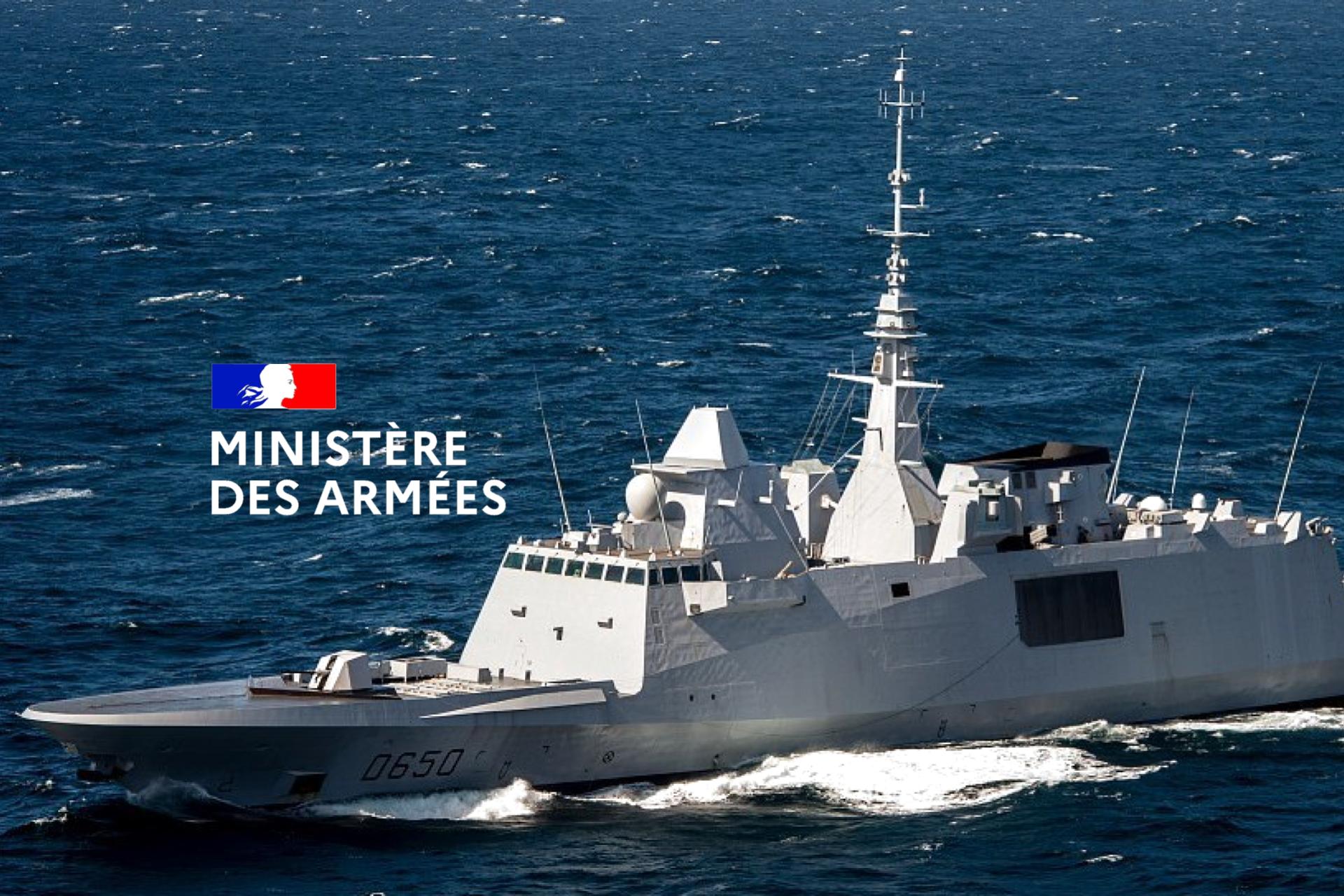Building a strong navy is hard work. By preparing its next armaments well in advance, the French Navy is giving itself the means to deal with the return of conflict at sea. Overview of current and future projects exhibited at the Euronaval show.
France must face, on land as at sea, the return of high intensity combat. The maritime environment is more than ever a place of competition, dispute and confrontation, placing itself at the heart of security issues. With the increase in the budget of our armed forces, provided for by the Military Programming Law (LPM) 2019-2025, the French Navy can count on modern and efficient equipment, thanks in particular to the work of the General Directorate of Armaments ( DGA) and our Defense Industrial and Technological Base (BITD). It also anticipates the threats of tomorrow by placing itself at the forefront of innovation, because preparing for the future also means staying one step ahead in this context of naval rearmament.
Renew surface buildings
The rejuvenation and strengthening of our fleet is already effective. The French Navy has received seven multi-mission frigates (FREMM) out of the eight planned by the end of the year. First-rate ships, they constitute the real backbone of a navy with an ocean vocation: the 45 days of autonomy, the projection capacity reaching 6,000 km and the new generation combat system make them a versatile tool and a political signal. and a strong military. Some of these frigates can even carry the ASTER 30 missile, with significantly higher performance (compared to the ASTER 15). Its function: to intercept and destroy all aerial threats. Reaching a speed close to 5,000 km/h, it can hit a target located more than 100 kilometers away.
The renewal of the surface fleet also means the upcoming arrival of the five Defense and Intervention Frigates (FDI), with a first delivery in 2024. The first French frigates natively protected against the cyber threat, they are capable of operating in all areas of warfare (anti-ship, anti-aircraft, anti-submarine) and are suitable for the projection of special forces. Powerfully equipped and endowed with numerous technological innovations, they will constitute, by 2030, one third of the leading French frigates.
“Building a navy involves long-term investments and betting on the future. » Sebastien Lecornu.
Read below transcript in English.
Inauguration of Euronaval
Since 2018, the preparatory work for the launch of the next generation aircraft carrier program (PA-NG) has been launched. Almost twice as large as the current Charles de Gaulle, it will be able to reach a speed of 27 knots, or 50 km/h and carry around thirty new generation combat aircraft. The key: greater control of maritime space and our deterrent force.
Different areas of struggle
Since it adopted a seabed strategy in February 2022, France has, for example, been developing devices capable of knowing, monitoring and acting up to 6,000 meters deep. A necessity to protect our strategic infrastructures such as submarine cables, on which we depend heavily for the transport of energy and digital data. It is also the development of the new Future Marine Mine Countermeasures System (SLAM-F). Objective: to leave the man out of the minefield via remote control or semi-autonomy of surface drones. “Once in the water, the onboard sonar is capable of imaging the seabed with a very high resolution to detect, locate and classify explosive devices”, explains Alain, head of the technical teams for the SLAM-F program at the DGA, during Euronaval. If a threat is detected, a teleoperated robot will destroy the targeted object. The first deliveries of this brand new system are expected at the end of 2023.
The French Navy is already reaping the benefits of an ambitious investment policy. The Suffren, the first nuclear attack submarine (SNA) of the Barracuda program, entered active service last June. With great acoustic discretion, it also benefits from improved endurance allowing extended operational deployments. Five others of the same class will follow by 2030.
In the air, the French Navy is also counting on the arrival of the Guépard Marine from the HIL program (Light Joint Helicopter). “
The objective is to produce a machine capable of carrying out the spectrum of the missions of the three armies with a controlled operating cost, ”reveals Captain Jean-Baptiste, in charge in particular of the coherence of aeronautical programs for the French Navy. Eventually, the first units will be delivered from 2029.
HLS.Today Projet-de-loi-de-finances---2023---LPM-ann--e-5
HLS.Today Source: Defense.Gouv.fr
Video Interview Transcript:
Hello and welcome to the Euronaval 2022 studio. We are lucky today to have captain Alexandre marches with us. Hello, hello Xavier. What is your role in the navy?
I am the commander of the navy’s press relations information service. I am also the communication advisor and spokesperson in this capacity.
Looking at the last few years, we see a lot of integration and new equipment; how is it going? This rise in power will go up where then actually, in the last few years, we have excellent examples this year, we have been on a relatively strong renewal of our equipment I can sweep them quite quickly. We also have some at the end of 2022 some exciting elements.
We have a lot of active service retirements because new abilities are coming, so the most recent skills are the frames we will soon receive last, the eighth frame, which is the second air defence frame we see. All that caused the withdrawal from service of the oldest frigates, the anti-submarine frigates, with the departure of the TREVILLE key recently. If I continue in other areas, there is the departure, for example, of the Alouette 3, which will be leaving us in December after 60 years of loyal service in the navy.
On the one hand, we have been replaced by an interim fleet of dolphins and by the first h160 delivered on September 22 to the navy transformation course. Here I can go underwater. We have the same thing with the admission to active service in June of the first Barracuda submarine, the Suffren, and very recently, the start-up from the boiler room, called the divergence of the dogecoin, the second in the series last month. All this entails the withdrawal of service from buildings or boats as soon as the oldest rubies very well, so when we look at everything, that is an evolution in terms of drones.
We think a lot about flying drones but there is also everything that is funny marit underwater drone do we also have innovations in this area so innovations we already uses drones on our surface vessels the two phras are equipped with small emerging drones which are now operational we also want to put smaller drones into service today to enhance the very old boats that are deep sea patrol boats the series of aviso at 69 we are on board what we call the smdm which is operational today and which allows it to see further, that is to say that we adapt old capacities with modern capacities for optimize performance so but we are also going to leave now we are going to start going underwater with the developments of the slamef program which therefore continues from the drone of the underwater drone to intervene in mine stations and more long term in the context of mastering the seabed of other drones, but I think we’ll talk about it again later, I’ll pass on to you that precisely that should matter it’s the evolutions what is it that you see as a big trend over the next few years.
In the next decade and suddenly what a program that are associated then there is you have to go back a little in the context I think you see like me that today the challenge and the use of force is developing it is true that we are looking at the Ukrainian conflict we necessarily have a very continental focus with the land battles but what happened for example on the cruiser Mozart or what happened on the Gazo du Nord Stream can also show that the sea is a space of dispute or even confrontation tomorrow so it is necessary and it is one of the strong axes that our Chief of Staff Admiral Vendiez wanted to have a combat navy and this combat navy it must be as at the peak.
Therefore these are the axes of tomorrow which fit perfectly into the new programs which have already been launched by the IDF frigates, for example, the first of which will soon be launched, that is also the case, so I said it earlier about slammed it will be tomorrow on the new new generation aircraft carrier which should replace the Charles de Gaulle in 2038.
Even on a component such as deterrence on the replacement of the current SNLs by the c’ was born the third generation which will allow us to go even further for 80 years and to keep capacities which will remain at the forefront and precisely on the pit which is like a major component for the navy these are major cases one of the four major commands the future nuclear ballistic missile submarines the evolution of the M51 there are also prospects yes it’s it’s its programs that are engaged of course that we don’t communicate a lot about it too bad but they are engaged.
We will see very soon in a little over 10 years the arrival of the successor to the current DSN so that they can guide it is that they can continue to carry out their mission I tell you almost 80 me until 2080 or even further with equipment always for a submarine a detectable is able to launch missiles which are effective and which guarantee us our credible deterrent structure I see a lot of bursts which revolve around us also developments on this side there and that the arrival of the F4 standard there are also many innovations which are specific to the navy.
Can you mention them?
So the innovation is of course the Light motif of a state-of-the-art navy innovations we see them in many areas there is one area that is very important is connectivity, it is having Marines a navy already capable of being connected buildings between aircraft between them but also with our allies and that it’s all the endorsements on naval cooperative watch which will allow, for example, a boat to engage a target which is seen by another in a time which is even faster than what is called real time are essential.
The developments and we can see it of course the Rafale with this standard it will not be the F4 which is very connected and which still allows it to go further compared to the current standard the F3R this innovation is also the expense of a capacity for agility of adaptability and that when we talk about the economy of war for the navy in the current context, that is to say that of the evil of a navy which needs to be in combat and at the forefront it is essential we need a navy that will adapt quickly is one of the axes that the chief of staff of the navy pushes.
That is to say to take what we did with the Rafale, that is to say to make it evolve step by step for example in the capacity in the construction of our future capacities and the second big characteristic by the innovations but we must not forget when it was combat navy it must also be resilient, that is to say that we resist the fire of the first shot and that we are able to fight that also means of the mass not necessarily precisely the mass it can be we have seen it for example which is very long and that the chief of staff recalls it on September 5 we commemorate the battle of the high chair the mass it can also be innovation it can also be talent it can be sailors who are able to look for other solutions to have another state of mind that’s also one of the major issues suddenly recruitment yes so I told you three axes in fact in the Mercator plan which is the plan that guides the navy the combat navy I put a lot of talk about the state-of-the-art navy.
I believe that in the naval we are at the heart of that and that is the talented navy so what is the talented navy what is a navy today which every year recruits 4000 young people it’s a navy which is young, which is around less than 30 years old on the ships and around 32 years old on average, and it’s a navy which must be able to train sailors for trades that we don’t find elsewhere or who are rare what you need to know is that today I am convinced that maybe 15 days ago there is a young person who entered the École des mousses who will be there he nuclear engineer who will lead the boiler room of Charles de Gaulle in 2000 sorry in 2038 or the first boiler room of an snl-e3g we recruit them today we train them in rare trades of very high technicality we make them progress the staircase social is always very important to us and behind it we have people who are able, with their skills combined with experience and older experience.
To bring a lot to the Navy of Talon one last point on the cooperation of major international programs we see that there are technical programs of the materials which is also shared t access to some of our partners but in terms of operational cooperation where are we then operational cooperation in fact this question which every time surprises us sailors when we are told about it it is in our DNA in made very small we work with allies who have NATO within the framework of the EU as soon as we carry out an operation as soon as we carry out an exercise we are never alone the chief of staff of the Navy recalled this summer when he was talking about Asia Pacific if we want to be credible in Asia Pacific Facing us competitors facing competitors it is necessarily with allies partners that we will get there so all that this state of mind that we have natively in the navy because we are sailors and because we work with other navies who have the same navy combat DNA advanced navy and who also want to fight against competitors we have it but it must also translate technically with equipment.
That is interoperable was talking about naval cooperative life it is not normal to study all these systems which are interoperable and it is also one of the keys to the success of the request it is also within the framework of NATO suddenly this integration in which we returned and we increased in power with the integrated command so that for the tactical level of course it changed absolutely nothing I was brought up in standards at the time we have always worked in procedure as much we have always been compatible if only on the data links with the optant the integrated command has not changed much for our tactical combat level but indeed it remains today we review it with the events in Ukraine and the somewhat greater reactivation of the essential naval forces at the time can you talk a little bit about the deployment we have seen that France has ensured protection and in particular the French navy ease ensured the protection of the southern flank with in particular with the surveillance and protection capabilities.
That you can do the Hokage we also had a deployment that was international because the deployment of the aircraft carrier was done with ships from other marines so that’s really the ultimate example you have to go even further in mentions there then this example to tell you about the Clémenceau 2022 mission the aircraft carrier was actually at sea when the conflict broke out in Ukraine first what is remarkable is to see that in less than 48 hours when you have a tool like a carrier battle group and tells you very well which is both full of submarine buildings of French aircraft but also allied in less than 48 hours we are able to reconfigure ourselves to completely change mission to turn from the East to the North and to be credible that is something that should be noted and that is also precisely because ‘we are interoperable we often say ent Plug and Play and the French boats are Plug and Play in other naval air groups like foreigners are Plug and Play with us so all that effectively made it possible very quickly to find the Chief of Staff very much likes this expression eye to eye with the Russian competitor in oriental meditation always with professional interactions of course and to go and do what are called reassurance missions on the eastern flank of southeastern Europe, most particularly with as you you said hawkai flights to gather intelligence and situation and burst flights typically reassurance flights that occurred at the same time as the air force flights a little further north in the Baltic countries or in Poland so a perfect coordination also with the commander buddies. thank you very much for this exchange. thank you Xavier.








